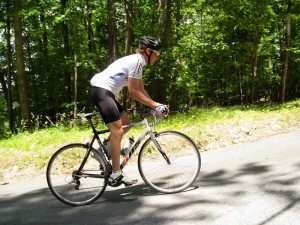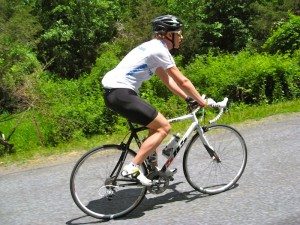 [dc]S[/dc]ince I posted about various climbing positions a couple of weeks ago, there has been some interesting questions and some interesting discussion on the idea of changing your climbing position.
[dc]S[/dc]ince I posted about various climbing positions a couple of weeks ago, there has been some interesting questions and some interesting discussion on the idea of changing your climbing position.
Specifically, some questions were posed as to why we slide backwards on the saddle. Or why do we switch positions (or should we switch positions) regularly on a climb?
Well, let's get a little deeper into that, shall we?
Muscle Composition
| The glutues maximus muscle is predominantly a ‘global’ or mobilising muscle. To utilise the fast twitch muscle fibres associated with power and sprinting, exercises that add weight must be performed (Mc Ardle et al., 1996). The Squat is a perfect exercise to strengthen gluteus maximus and help the cycle sprint.[……]The Gluteus medius and minimus group are documented to be ‘stabilising’ muscles that have predominately slow twitch muscle fibres. They that act as pelvic/hip stabilisers by preventing the knee dropping inwards on the bike so that lower limb biomechanics are more efficient. These groups require low load exercises and high repetition. |
| The large gluteus maximus is made up of 52.4% type I fibers and 47.6% type II fibers, while the gluteus medius and minimus are composed primarily of slow twitch tonic fibers (see: Muscle Fibers Part One). To understand how to apply these ratios for the goal specific purposes see, Muscle Fibers Part Two and Monumental Masterpiece – Creating A Cerebral Portrait. |
 Biomechanical Advantage
Biomechanical Advantage
In addition to the fiber composition of the muscles utilized, there is also a biomechanical advantage to sliding back on your saddle. Because of the inherent design of the lower limb, the extension of the leg (straightening of the hip, knee and ankle) is the most powerful motion in the body. By sliding backwards on the saddle, you position yourself to more fully take advantage of the immense power of that motion, and can thereby climb a fairly brisk, steady pace for longer periods of time. More information can be found here.
| In this situation these joints are the hip, knee, and ankle.When we are in the terminal stance, we have flexed and loaded these 3 joint structures. With the knee tilted, simultaneous triple extension will effectively push the COG [center of gravity] toward the next cone.When correctly orchestrated, this triple extension can be the most powerful motion the body can produce. This has been demonstrated by the huge power outputs measured by lifters performing Olympic lifts (which are based on this triple extension). This motion needs to practiced and perfected. |
Switching positions
As I stated in my previous entry, it is very helpful to switch positions occasionally. Even though the large extensor muscles are slower to fatigue, they certainly will, especially if you're pushing the pace over your anaerobic threshold. In those circumstances, it makes perfect sense to slide to the front of the saddle or stand on the pedals to give the extensor group a rest (mainly by engaging the flexor groups.) Remember, in climbing situations, just like your ride routes, variety is the spice of life.
Thanks for the great comments and discussion on how to climb better. As always, leave me a comment and let me know if there are questions or thoughts about anything I may have missed.
Following up on the comments below… maybe a better way to frame the sitting versus standing discussion, is in terms of energy management.
I’ve been riding with a new group lately, and doing lots of new routes. It really drives home how much harder it is to climb an unfamiliar hill! Getting to the top with energy in reserve means you are not climbing with your full potential, and on a tough climb with a strong group might mean you are the last one up. But running out of energy before the top is a total disaster. Reading the hill in real-time (rock climbers call it “on-sighting”) becomes a critically important skill, as you wrote below — looking for treetops beyond the visible crest, looking uphill left and right to see if there is a chance that a hidden switchback might make the climb longer than it appears from your current viewpoint.
It’s also valuable to watch the other riders in the group to see if they are transitioning from grinding to attacking, or vice versa. If the strongest climber in the group is sitting with his hands on the tops and a steady cadence, it’s an excellent sign that there’s more to come. If he attacks, it means the end is probably near. (If he attacks long before the top of the climb, it still means the end is near, just not the end of the climb.. 🙂 )
I meant to add, I’d love to see a post dedicated to reading the road.
I don’t want to hog the comments here, but this topic is something I spend a lot of time thinking about, because our area has so many challenging hills. (When I say “challenging” I mean hills like the steep ones listed here, which are generally more than a mile of 7% or higher grade, and includes some 20%+ killers).
Climbing a tough hill takes as much mental conditioning as it does physical conditioning. Regardless of your skills and conditioning, a big hill will make you hurt, there’s just no way around it. I personally find a lot of the challenge when doing a hill solo is getting myself into the mental state where I believe the only way off the hill is over it. Even the pros will say that you can’t succeed as a climber unless you know how to suffer.
So, what does it mean to “know how to suffer”? Do you say “shut up, legs” like Jens Voigt, or try to zen out and embrace the pain? When climbing solo, sometimes I will imagine that I’m riding with somebody I’d be embarrassed to quit in front of. There are probably all sorts of mental tricks that people use.
Mentally, it’s really whatever works for you. I have “Shut Up Legs” as the final line on my RoadID just as a reminder. Sometimes it is just the zen of the scenery, or watching the people in front of me, or refusing to quit in front of the folks behind me.
Everyone needs to find their own mental fortress against incessant, brutal climbs, and that’s something that’s not really teachable, but it is learnable (if that makes any sense.)
In relation to your other comments, a post on “reading the road” is a great idea. I’ll have to go ride a bit more to get my thoughts on that one in order.